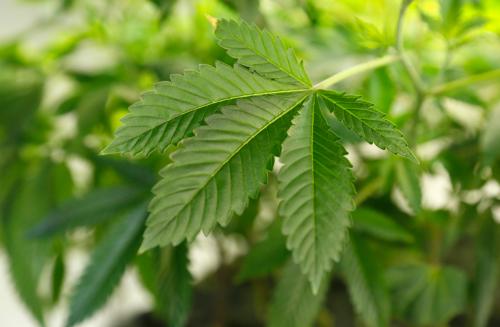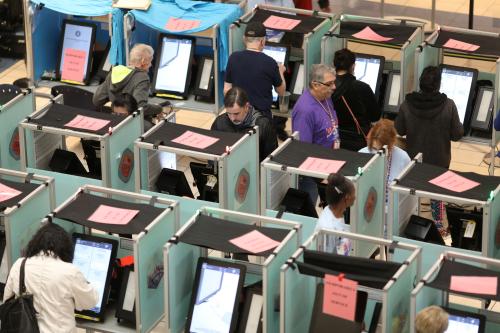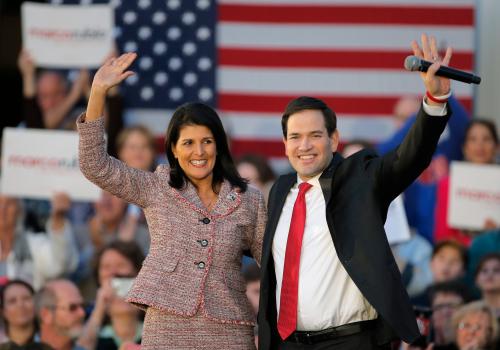Maryland’s election asked two million voters to choose a new governor and decide whether to allow adults to purchase and use cannabis legally under state law. Democrat Wes Moore and saying “yes” to cannabis each got almost the exact same number of votes, 1.302 million. The top line similarity fades when examined geographically. Cannabis won a majority in 23 of 24 Maryland counties, losing only one of the smallest by one percent. Moore by contrast won only 11 of the 24 but with support varying from over 90% to as low as 23%. Where Maryland voters diverged explains why the politics of cannabis scramble party lines and why cannabis’s broad coalition has been unable to translate state level victories into federal legislation.
First the data. The figures below compare the vote across Maryland. Cannabis is consistently popular as support for it hovers between 60% and 70% (Figure 1) throughout the state, unlike Democrat Wes Moore’s vote share (Figure 2), which shows more variation. Because the chart is not weighted by population, it may seem like cannabis is more popular, but the gaps where Moore outpolls cannabis are where the people are, such that the total votes are nearly identical.
Moore followed the traditional Democratic path to victory: racking up big margins in heavily populated Democratic strongholds while losing rural areas by wide margins. One million of Moore’s 1.3 million votes came from Maryland’s six largest jurisdictions, the DC-Baltimore I-95 corridor where Moore won cities and suburbs. Moore’s 77-23% margin on the I-95 corridor was more than enough to withstand sharp losses in western Maryland and the eastern shore.
However, cannabis underperformed Moore in Democratic strongholds by seven points. The two largest places where cannabis trailed Moore were Baltimore City, by 12 points and Prince George, by 19. Prince George and Baltimore City share many Black constituents (64% and 62% Black respectively), but economically are quite different. Prince George is a wealthy suburb with a median household income of $91,000, while Baltimore is a city with a much lower median income of $54,000 and more and deeper pockets of poverty. This is evidence that the reduced popularity of cannabis compared to Moore among Black voters extends across the income spectrum and in this case was even more pronounced among more affluent communities.1 This pattern contrasts with wealthier, super majority white suburbs like Howard and Anne Arundel counties that combined mirrored the state, giving Moore and cannabis nearly identical support. Black voters in Maryland appear less sold on the benefits of cannabis than their fellow Democratic white voters, regardless of income.
Maryland is a political sandwich with a blue streak between two red sides. Western Maryland is adjacent to, and votes like, West Virginia. Allegany County favored the Republican candidate for Governor 68-32% in 2022, similar to its Trump/Biden outcome in 2020. Yet those same voters voted for cannabis 58-42%, a 26-point difference. The same is true on the Eastern Shore of Maryland, which votes like the deep south. Caroline County went 67% for the Republican for Governor (the same as Trump in 2020) but cannabis won 60-40%. More than one in four voters in both of these counties voted Republican at the top and “yes” for recreational cannabis a few spots down the ballot.
Maryland’s election in November was similar to others; 22 states across the political spectrum now allow adult use and 47 states have some form of legal medical cannabis. Despite this, Congress has done little to change federal law, with legislation in stalemate on everything from full scale legalization to incremental change for banks trying to handle the growing business of state licensed cannabis.
Cannabis consistently wins a majority of voters in Republican areas. This coalition draws heavily from the Democratic minority in these red areas, but significantly from the Republican majority. Determining whether it is a majority of Republican voters would require greater data. However, it seems likely that Republican primary voters would be less supportive of cannabis than Republican general election voters. Age is a key factor. Primary voters tend to be older, particularly Republican primary voters, and older Americans are less likely to support legalizing cannabis. As Republican voters move more right-wing, support for non-medicinal cannabis falls: only 37% of self-defined conservative Republicans supporting it compared to 60% of moderate or liberal Republicans. This helps explain why Republicans in Congress in highly gerrymandered districts (Maryland is among the most gerrymandered states in the country) may be particularly concerned with supporting cannabis as their only electoral vulnerability occurs on primary day.
Cannabis is even more popular in Democratic territory, but as Maryland’s election results show, cannabis was less popular than the party’s standard-bearer — even as that standard-bearer was vocally supportive of cannabis reform. In areas where members of Congress are more concerned with keeping their base happy with a greater focus on primary challengers than general elections, candidates have an incentive to be more cautious on cannabis.
In this hyper-polarized world, it is unclear if voters are willing to cross party lines for cannabis. Florida’s 2018 election offered one example where they were — Nikki Fried was the only Democrat to win statewide election, running on an aggressively pro-cannabis agenda for agriculture commissioner. Voters are more willing to cross party lines for statewide office than for federal — witness the Democratic governors of Kansas, Louisiana, and Kentucky, and Republican governors of Vermont, and for the prior eight years, Maryland and Massachusetts.
Voters are willing to take positions on simple ballot questions regarding cannabis that are not part of their party orthodoxy. Maryland’s experiment, which had the same two million voters on the same day last November, produced a geographically diverse but consistently broad show of support for cannabis: 10 of the 24 counties were within five points of the overall 67-33% margin for cannabis. Party politics diverge sharply with 22 of the 24 counties finishing more than five points from the same margin overall. Put another way, the worst that cannabis did in any county was 49%, Moore was at 40% or worse in eight with a low of 23%.
Maryland’s state legislature did not pass legislation to change cannabis, as other states like Connecticut, but rather punted the issue to voters. Legislators knew the issue would pass by referendum. The choice to have voters choose on cannabis may reflect the unease some state legislators felt opposing something supported by a majority of their constituents. Contrast this process with legalization of same-sex marriage, another hot-button cultural issue the Maryland legislature passed in 2012, rather than send to voters. On that issue, state legislators were willing to vote their conscience perhaps because they knew it aligned more closely with their constituents.
Politics can be thought of as a battle between constituencies, as opposed to the traditional construct of contrasting ideologies. The constituencies that support legalized cannabis split the Democratic and Republican parties in slices not often replicated. Younger Americans are one constituency more supportive of cannabis legalization regardless of political party. Age can be confounded with race as younger Americans are overwhelmingly less white than older Americans. But age alone is unlikely to explain why rural Republican areas of Maryland voted for cannabis legalization and why cannabis lagged the African American Democratic gubernatorial candidate in heavily Black counties.
Maryland’s political constituency in support of cannabis is probably representative of America’s majority in favor of cannabis: broad, bipartisan, and geographically and ideologically diverse. Fifty-nine percent of Americans support legalizing adult recreational cannabis usage, while an even greater 88% support legalizing cannabis for medical purposes according to the Pew Research Center’s poll conducted in November 2022. Many of these voters may be cannabis users, Maryland’s cannabis sales more than doubled in the first month recreational use went into effect. Others may be libertarians who believe in greater individual choice and fewer government restrictions.
Some of those who oppose cannabis may be African Americans who do not think that the new industry will create wealth for their community. Previously, Black Maryland legislators voiced anger at the distribution of cannabis licenses and investments which skewed toward white owned businesses. Others may be liberal whites who are concerned about cannabis dispensaries in their neighborhoods — often known as NIMBY’s. If they are not users and have reason to believe that cannabis users they care about will not be prosecuted under existing law, as whites disproportionately are not prosecuted relative to Blacks, then they may be ok with the status quo. As a lifelong resident of Montgomery County, Maryland, I can attest to a large constituency of liberal, white NIMBYs (who have inspired a Twitter NIMBEE satire account).
Maryland voters across a state that has slices representing different portions of America, reached near universal majority support, despite sharp political divisions. That federal legislators are unable to make even moderate movement toward an area of consensus agreement by Americans across the geographic-political spectrum is further evidence that members of Congress are not being moved by the majority of their constituents’ positions, especially on cannabis.
Cannabis reformers have been smart to focus on appeals directly to voters. Many states allow for this through referendum, but the American system does not provide for national referenda. A national referendum to allow citizens to speak directly to this question would likely result in a radically different path for cannabis policy. As Maryland demonstrates, a broad majority can be found through different groupings rather than through our two political parties.
-
Footnotes
- Wes Moore became Maryland’s first Black governor and first Black state-wide elected official. As a check against the hypothesis that Moore’s race drove unusually high support in these areas, I checked the 2020 election. Biden received 89% of the vote in Baltimore and 91% of the vote in P.G. (2-way vote share), similar to the 91% that Moore received in both jurisdictions.







Commentary
Maryland’s cannabis politics offers insights for the nation
September 7, 2023